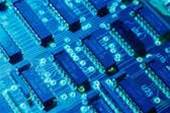
With the integrated circuit industry facing concerns of the limits of miniaturisation for two-dimensional chips, 3D, vertically stacked circuits are expected to be the next major advance in computer processors.
But getting the vertical layers of a 3D chip to act in harmony is no mean feat, according to Eby Friedman, Distinguished Professor of Electrical and Computer Engineering at the University of Rochester.
Friedman liked designing a 3D chip to devising a traffic control system for the entire U.S. -- and then layering two more countries above the first, and somehow getting every bit of traffic from any point on any level to its destination on any other level.
With a team of researchers at the University of Rochester, Friedman has designed a 3D chip that vertically optimises key processing functions in the same was as how ordinary chips optimise functions horizontally.
Unlike past attempts at 3D chips, the Rochester chip is not simply a number of regular processors stacked on top of one another -- its design enables tasks such as synchronicity, power distribution, and long-distance signalling to function fully in 3D.
The design also accounts for different impedances that might occur from chip to chip, different operating speeds, and different power requirements.
“I call it a cube now, because it's not just a chip anymore,” Friedman said. “This is the way computing is going to have to be done in the future.”
“When the chips are flush against each other, they can do things you could never do with a regular 2D chip,” he said.
The Rochester chip was fabricated at MIT and features millions of holes drilled into the insulation that separates the layers in order to allow for the myriad vertical connections between transistors in different layers.
Since each layer could be a different processor with a different function, such as converting MP3 files to audio or detecting light for a digital camera, Friedman says that the 3D chip is essentially an entire circuit board folded up into a tiny package.
He says the chips inside something like an iPod could be compacted to a tenth their current size with ten times the speed.
“Are we going to hit a point where we can't scale integrated circuits any smaller? Horizontally, yes,” he said.
“But we're going to start scaling vertically, and that will never end -- at least not in my lifetime. Talk to my grandchildren about that.”


.png&h=140&w=231&c=1&s=0)
_(22).jpg&h=140&w=231&c=1&s=0)
_(20).jpg&h=140&w=231&c=1&s=0)




_(26).jpg&w=100&c=1&s=0)

 iTnews Executive Retreat - Security Leaders Edition
iTnews Executive Retreat - Security Leaders Edition










_(1).jpg&h=140&w=231&c=1&s=0)



